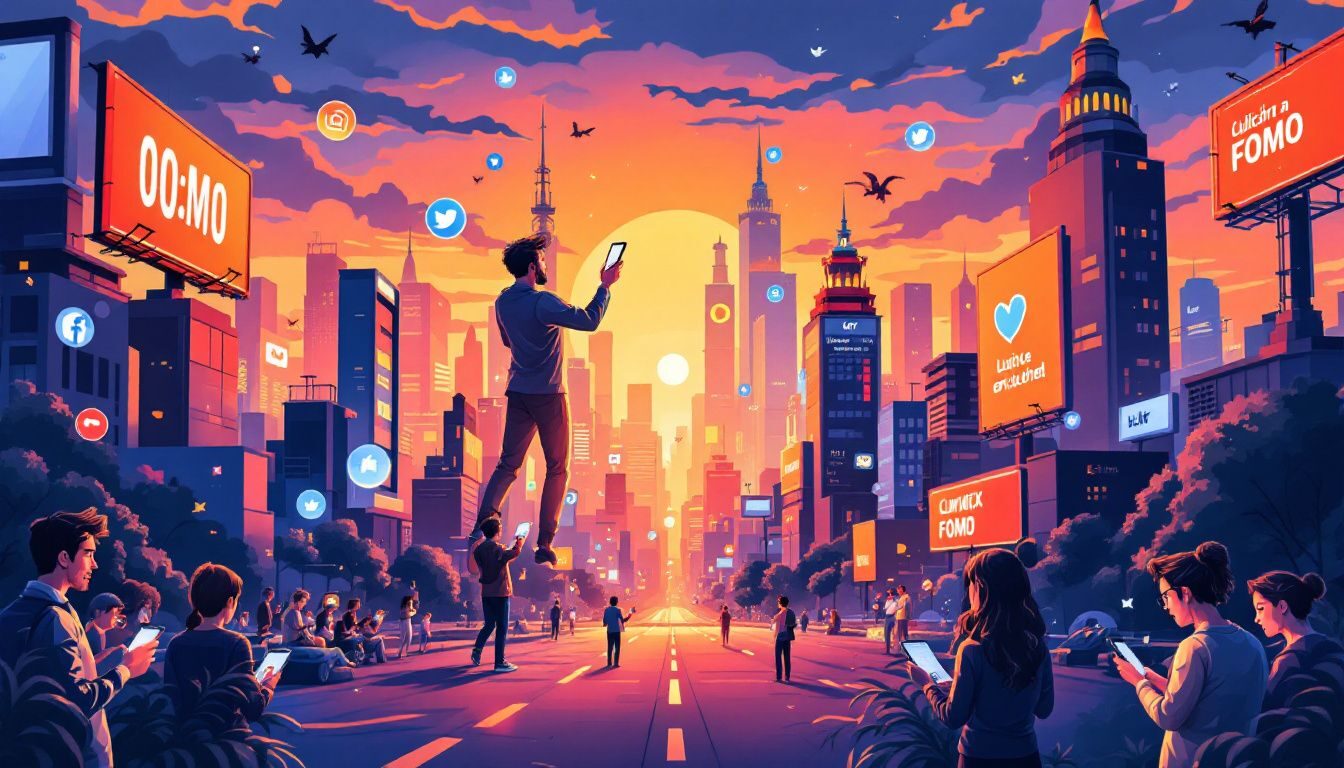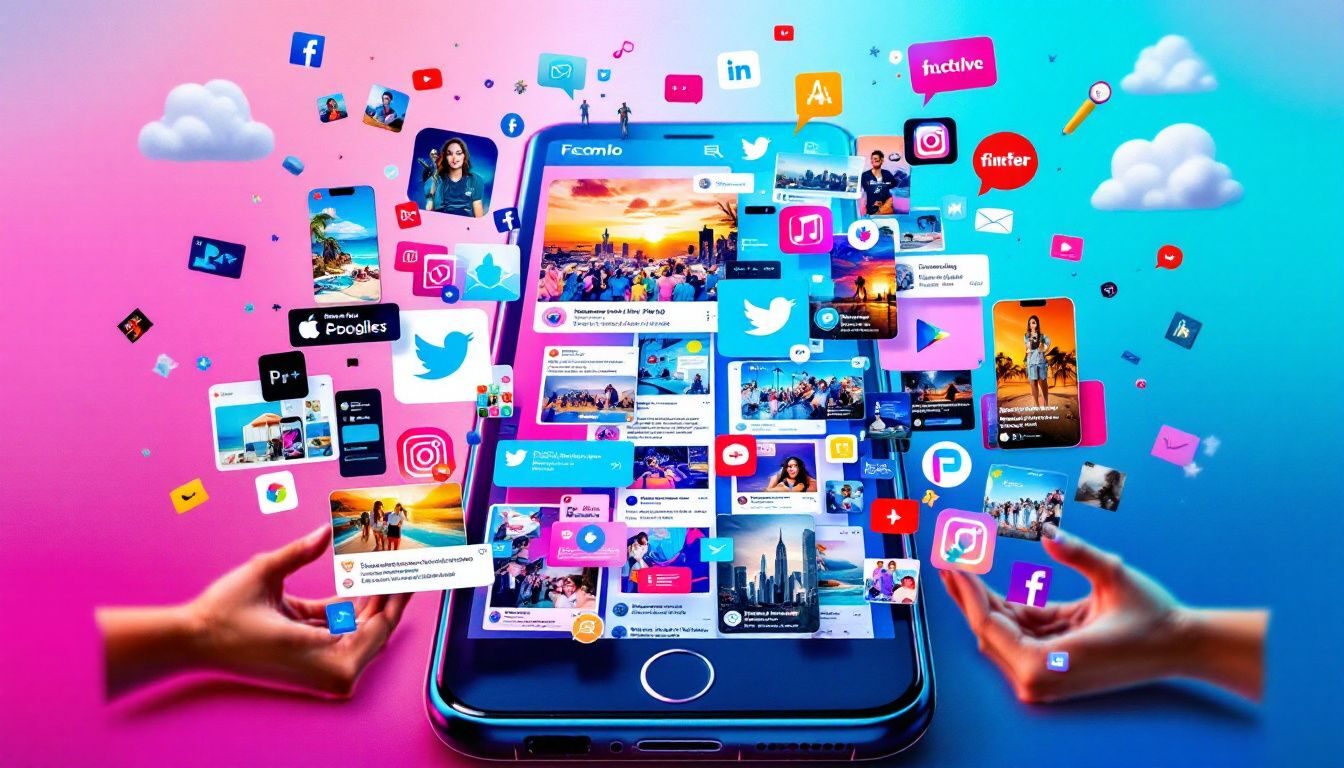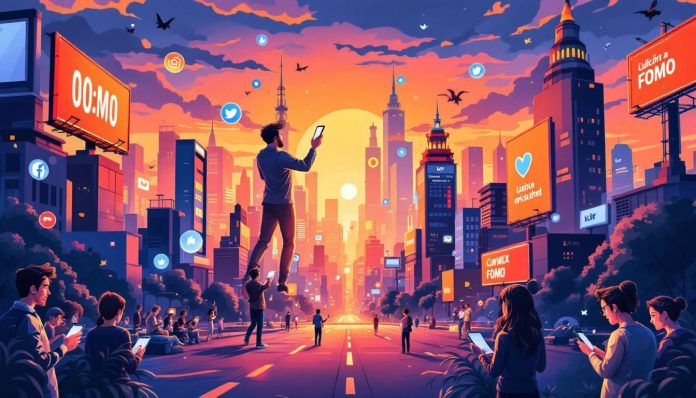Create your very own Auto Publish News/Blog Site and Earn Passive Income in Just 4 Easy Steps
FOMO, or ‘Fear of Missing Out,’ is the anxiety you feel when you believe others are having experiences that you’re not. This fear can lead to compulsive social media checking. This article will explain what is FOMO, its causes, and its effects.
Key Takeaways
-
FOMO, or Fear of Missing Out, stems from the human need for social belonging and can lead to anxiety, impulsive behavior, and negative emotional states when unmet.
-
In marketing, FOMO is effectively utilized through tactics like urgency and scarcity, and it often leverages psychological triggers such as loss aversion and social proof.
-
Ethical FOMO marketing requires authenticity and transparency; deceptive claims can harm brand trust and lead to buyer’s remorse among consumers.
Definition of FOMO
The term ‘Fear of Missing Out’ (FOMO) was first introduced in 2004 to describe a phenomenon closely linked to the rise of social networking. It encapsulates the anxiety that arises when individuals perceive that others are having fulfilling experiences that they are not part of. This feeling of exclusion can be pervasive and deeply unsettling.
In 2013, British psychologists provided a more formal definition of FOMO as a persistent fear that others are enjoying rewarding experiences while one is absent. This definition highlights the emotional distress and compulsive need to stay connected, which are hallmarks of FOMO. This fear extends beyond missing events or activities to include anxiety about not being part of a social circle or missing important updates.
A key characteristic of FOMO is the compulsive need to stay connected to others’ activities, which often results in feelings of exclusion from rewarding experiences. The fear that others are having more fun drives this compulsiveness, resulting in constant checking of social media and other platforms for updates.
FOMO involves two main processes: recognizing the feeling of missing out and the compulsive behavior to maintain social connections. This awareness triggers unease, prompting behaviors like incessantly checking phones or social media feeds to reduce discomfort. This behavior can become habitual, reinforcing the cycle of FOMO.
Origins of FOMO
The concept of FOMO, or Fear of Missing Out, has its roots in the early 2000s. However, it wasn’t until the rise of social media that FOMO became a widespread phenomenon. Platforms like Facebook, Twitter, and Instagram created an environment where people could share their experiences and connect with others in real-time. This constant stream of updates led to a sense of urgency and anxiety among users, who felt pressure to stay connected and up-to-date with events and activities.
Marketing strategies have also played a significant role in perpetuating FOMO. Companies use tactics like limited-time offers, scarcity marketing, and exclusive deals to create a sense of urgency and encourage customers to make purchases. For instance, flash sales and countdown timers are common techniques that leverage FOMO to drive quick consumer actions. This can lead to a cycle of anxiety and stress, as consumers feel pressure to keep up with the latest trends and offers.
The marketing industry has effectively harnessed FOMO to boost engagement and sales. By understanding the psychological triggers behind FOMO, marketers can craft campaigns that resonate with their audience and prompt swift action. However, it’s crucial to balance these strategies with ethical considerations to maintain consumer trust and loyalty.
Psychological Basis of FOMO
The psychological basis of FOMO is deeply rooted in the human need for social belonging. When this need is unmet, it can foster negative emotional states, such as anxiety and depression. Fear of missing out on social interactions can foster feelings of social inferiority and loneliness, which may be short-lived or chronic.
FOMO is closely linked to social anxiety, where individuals worry excessively about their social presence and how they are perceived online. This anxiety can drive individuals to constantly check their social media accounts, seeking validation and reassurance from their online interactions. It’s a vicious cycle that can lead to heightened stress and decreased self-esteem.
Various psychological theories provide insights into how individuals experience and manage FOMO. Attribution theory, for instance, explains how people attribute their feelings of missing out to external factors, such as others having more exciting lives. The transtheoretical model, on the other hand, offers a framework for understanding how individuals can be supported in managing their FOMO by recognizing the stages of change they go through.
Marketers must understand these psychological underpinnings to craft strategies that tap into such emotional responses. Addressing the core emotional needs and anxieties that drive FOMO enables marketers to create more effective and empathetic campaigns.
Building Resilience and Self-Esteem
Building resilience and self-esteem is crucial in today’s fast-paced and competitive world. While marketing campaigns often focus on promoting products and services that promise to improve our lives, they can also perpetuate unrealistic expectations and low self-esteem. This is where the role of marketing managers and specialists becomes vital.
To build resilience and self-esteem, it’s essential to develop a growth mindset and focus on self-care. Practices like meditation, exercise, and spending time in nature can significantly enhance mental well-being. Additionally, surrounding yourself with positive influences and supportive people who encourage and uplift you is key to fostering a healthy self-image.
In the context of marketing, it’s important to be aware of the potential impact of marketing campaigns on our self-esteem and resilience. Marketing managers and specialists should strive to create campaigns that promote positive body image, self-acceptance, and inclusivity. For example, campaigns that highlight diverse body types and celebrate individuality can help create a more supportive and empowering environment for consumers.
In terms of SEO, incorporating keywords like “self-care,” “resilience,” and “self-esteem” can help attract users who are searching for content related to personal growth and development. By optimizing content with these keywords, marketing specialists can increase their online visibility and reach a wider audience.
In conclusion, building resilience and self-esteem is essential in today’s fast-paced world. By developing a growth mindset, focusing on self-care, and being aware of the potential impact of marketing campaigns, we can create a more supportive and empowering environment for ourselves and others. Marketing campaigns that promote positive messages can play a significant role in fostering a healthier society.
FOMO in Marketing Strategies

FOMO marketing leverages key psychological triggers such as:
-
Loss aversion, which refers to the idea that people are more motivated to avoid losses than to acquire gains
-
Social proof, the tendency to follow the actions of others, particularly in uncertain situations
-
Time pressure, which creates a sense of urgency, compelling quicker decisions
These triggers drive customer actions effectively.
Urgency and scarcity are fundamental tactics used in FOMO marketing. Creating a sense of urgency through limited-time offers or flash sales can prompt consumers to act quickly, fearing they might miss out on a great deal. Scarcity, on the other hand, involves limiting the availability of a product or service, making it more desirable because it appears exclusive or rare. Search engine marketing (SEM) can be used to create high-visibility links and drive quick consumer actions.
Countdown timers are a common tool in FOMO marketing, visually communicating the urgency of an offer and encouraging immediate action. When customers see a ticking clock, they are more likely to make a purchase decision quickly. This tactic not only drives sales but also enhances the overall customer experience by creating a thrilling sense of urgency. SEO marketing enhances the visibility of these urgent offers in search engine results.
However, it’s essential to maintain authenticity in urgency. Authentic urgency fosters customer trust and enhances the overall marketing experience. Deceptive tactics can backfire, leading to distrust and negative brand perception. Therefore, marketers should ensure that their urgency messages are genuine and transparent.
Digital Marketing and FOMO

In the realm of digital marketing, FOMO is a powerful tool to enhance consumer engagement, urgency, and responsiveness. Marketers create a sense of exclusivity and scarcity to encourage swift consumer actions. For instance, limited-time promotions and flash sales are highly effective strategies that instill a sense of urgency in consumers, prompting them to act quickly.
Several tools can enhance the impact of FOMO in digital marketing. WiserNotify provides real-time notifications of actions taken by other visitors, which can enhance trust and prompt users to engage. Prove Source displays real-time customer behaviors on websites, cultivating credibility and increasing conversion rates. The FOMO platform showcases recent customer interactions, helping build urgency and trust among potential buyers. Additionally, search engine optimization (SEO) is crucial in increasing the visibility of these tools and strategies in search engine results.
Influencers play a significant role in amplifying FOMO by showcasing desirable products to their followers. Using influencers in marketing campaigns can build credibility and create a sense of urgency among consumers. Additionally, incorporating social proof, such as customer reviews and recent purchases, can enhance trust and motivate visitors to take action.
Effective FOMO marketing also involves personalization. Tailoring urgency messages based on user behavior can significantly boost engagement and conversion rates. For example, personalized email subject lines conveying urgency can lead to higher open rates and consumer action in event marketing content marketing.
Social Media’s Role in FOMO

Social media plays a pivotal role in amplifying FOMO. People often feel compelled to check their social media accounts due to a persistent anxiety about missing out on interactions or events, which can lead to negative mental health outcomes. This compulsive behavior is driven by self-control issues and the fear of being excluded from social circles or missing important updates.
Compulsive checking of social media can be compared to addiction behaviors, where individuals feel an intense urge to stay connected. High levels of uncertainty avoidance can heighten FOMO, making individuals seek constant social validation and engagement online. This constant need for validation can lead to impulsive purchasing decisions as users strive to keep up with what they see on their feeds.
Influencer partnerships amplify FOMO by leveraging their credibility to drive consumer interest and prompt action. User-generated content serves as social proof, enhancing trust and increasing the perceived value of experiences. Social media enhances FOMO by displaying curated experiences, which often lead to impulsive purchasing decisions among users.
The real-time nature of social media updates intensifies FOMO, encouraging quick consumer actions to avoid missing out. Engagement metrics like likes, shares, and comments are vital for assessing the impact of FOMO strategies on social media marketing and social media engagement. These metrics reflect how well a campaign resonates with the audience and drives engagement.
Impact of FOMO on Consumer Behavior and Brand Loyalty
FOMO has a significant impact on consumer behavior, often leading to impulsive purchases based on social media posts. For example, seeing a friend’s post about a concert or a flash sale can prompt users to make quick purchasing decisions to avoid missing out on the experience. This impulsiveness is a direct result of the anxiety and urgency created by FOMO.
However, the fear of missing out can also lead to negative effects, such as buyer’s remorse. Impulsive purchases driven by FOMO that fail to meet consumer expectations can lead to regret and dissatisfaction. Therefore, aligning marketing messages with genuine value propositions is crucial to avoid disappointing customers.
Around 60% of millennials reportedly make impulsive purchases influenced by FOMO. This demographic is particularly susceptible to FOMO due to their high engagement with social media. Marketers can leverage this insight by crafting campaigns that tap into millennials’ fear of missing out.
Real-world examples illustrate the effectiveness of FOMO in driving consumer behavior. For instance, Airbnb highlighted a significant increase in demand for vacation rentals, informing potential customers of a 44% rise in searches for a popular destination. Testimonials and social proof not only validate products but also induce FOMO by showing potential customers that others are benefiting from the product.
Managing FOMO in Marketing
Managing FOMO in marketing requires a balance between creating urgency and maintaining ethical standards. Ethical FOMO marketing relies on transparency, avoiding deceptive claims about product availability. It’s essential to ensure that the urgency communicated to customers is genuine and not misleading.
Limited-time offers and flash sales are effective techniques to stimulate a sense of urgency, prompting consumers to make quicker purchasing decisions. Countdown timers can visually communicate urgency on websites, compelling visitors to act quickly. These tactics can drive immediate action and boost sales.
Early bird discounts are another strategy to incentivize prompt action, urging customers to take advantage of offers before they expire. Limiting stock availability in marketing messages can foster a fear of missing out, encouraging quicker purchases. These tactics create a sense of exclusivity and urgency that can significantly impact consumer behavior.
Exit-intent campaigns are designed to capture potential customers who are about to leave a site by presenting last-minute offers that encourage purchases. Exclusive access promotions, such as member-only deals, can also create a sense of belonging and urgency, driving sign-ups and fostering customer loyalty through inbound marketing.
Real-World Examples of FOMO Marketing

Real-world examples of FOMO marketing illustrate its effectiveness in driving consumer actions. Soylent, for instance, employs urgency in their campaigns by offering substantial discounts with a strict deadline. This approach prompts quicker purchasing decisions, as consumers fear missing out on significant savings.
Another example is the restructuring of pricing for an ‘Enterprise Plan’, which led to a 50% increase in enterprise sign-ups within three months. This demonstrates how urgency and pricing adjustments can significantly boost sales and marketing effectiveness. Informing potential customers about limited-time offers or exclusive deals can drive immediate action and boost conversions.
Urgency in print marketing campaigns can be a powerful motivator. When consumers perceive that they have a limited time to take advantage of a marketing campaign, they are more likely to act quickly. This tactic can be applied across various industries, from retail to services, to create a sense of immediacy and drive sales. Marketing refers to strategies that leverage this urgency as part of a marketing strategy to enhance consumer response.
These examples highlight how employing FOMO tactics such as urgency and pricing restructuring can significantly boost sales and marketing effectiveness. Understanding the psychological triggers behind FOMO allows marketers to create campaigns that resonate with their audience and prompt swift action.
Addressing FOMO in Your Audience
Addressing FOMO in your audience involves understanding their psychological needs and crafting strategies that resonate with them. Enhancing self-esteem can mitigate feelings of FOMO, as individuals who value their worth independently of online interactions are less likely to experience anxiety about social media. This can be achieved through positive messaging and highlighting the intrinsic value of your products or services.
Combining FOMO tactics with clear value propositions increases the likelihood of customer engagement. When consumers understand the benefits they will gain from a product or service, they are more likely to act on their fear of missing out. This dual approach ensures that the urgency created by FOMO is backed by genuine value.
Exclusivity in offers, such as special discounts for specific customer groups, can enhance brand loyalty while mitigating their fear of missing out. Creating real-time notifications of purchases can encourage casual visitors to become motivated buyers. This tactic leverages social proof to build trust and urgency simultaneously.
Incorporating social proof, such as recent customer purchases, enhances trust and can lead to higher conversion rates. Exclusive access to promotions for members can drive sign-ups and foster a sense of belonging. Addressing FOMO is crucial for brands to build better relationships and strategies with their audience, ultimately leading to lasting customer loyalty.
Tools and Techniques for Measuring FOMO
Measuring the effectiveness of FOMO-driven marketing strategies requires robust tools and techniques. Marketing research encompasses all research in marketing, while market research focuses on a specific target market. This distinction is crucial for understanding how various segments of your audience respond to FOMO tactics within the marketing mix.
Industry research plays a vital role in determining appropriate product pricing and understanding competitive dynamics in the marketing industry. By analyzing market trends and consumer behavior, marketing managers can fine-tune their FOMO strategies to better meet customer needs and expectations.
Metrics like customer retention and lifetime value are essential for assessing the long-term effectiveness of FOMO marketing. High customer retention rates indicate that FOMO tactics are not only driving initial purchases but also fostering ongoing loyalty. Lifetime value, on the other hand, measures the overall profitability of a customer over their relationship with the brand, providing insights into the sustainability of FOMO-driven strategies.
Summary
FOMO, or the Fear of Missing Out, is a powerful psychological phenomenon that has significant implications for marketing. By understanding its definition and psychological basis, marketers can craft strategies that leverage FOMO to drive consumer engagement and sales. The use of urgency, scarcity, and social proof are key tactics in FOMO marketing, effectively prompting consumers to act quickly to avoid missing out.
Digital marketing platforms, particularly social media, play a critical role in amplifying FOMO. Influencer partnerships, user-generated content, and real-time updates are effective ways to create a sense of urgency and prompt consumer action. However, it is essential to manage FOMO ethically, ensuring transparency and authenticity in marketing messages to maintain customer trust.
Real-world examples demonstrate the effectiveness of FOMO in driving sales and increasing conversions. By addressing FOMO in your audience and using tools and techniques to measure its impact, brands can build stronger relationships with their customers and foster long-term loyalty.
In conclusion, FOMO is a powerful tool in the modern marketer’s arsenal. By understanding its nuances and applying it thoughtfully, you can create compelling marketing campaigns that resonate with your audience and drive significant results. Embrace the power of FOMO and watch your marketing efforts soar!
Frequently Asked Questions
What is FOMO slang for?
FOMO is slang for “fear of missing out,” which describes the anxiety of feeling left out of enjoyable experiences others are having, often amplified by social media. It’s a common feeling in today’s connected world, prompting people to frequently check what others are doing.
What is FOMO and how does it impact marketing?
FOMO, or the Fear of Missing Out, is a powerful psychological trigger that marketers use to create urgency and compel consumers to act quickly. By highlighting limited-time offers or exclusive experiences, brands can effectively motivate purchases and engagement.
How can FOMO be used in digital marketing?
FOMO can effectively enhance digital marketing by employing strategies such as limited-time offers, countdown timers, and social proof, which create a sense of urgency and exclusivity. By partnering with influencers, brands can further amplify this effect, driving higher engagement and conversions.
What are some tools to enhance FOMO in marketing strategies?
To enhance FOMO in marketing strategies, consider using tools like WiserNotify, Prove Source, and the FOMO platform for real-time notifications. Additionally, employing personalized urgency messages and compelling email subject lines can significantly increase customer engagement.
How does social media amplify FOMO?
Social media amplifies FOMO by presenting curated experiences and real-time updates, which creates a sense of urgency to engage and not miss out on popular trends and events. This constant exposure encourages quick consumer actions driven by the fear of being left behind.
Want More Email Marketing Tips?
Looking for more in-depth advice on how to grow your list, plan seasonal campaigns, or automate your post-purchase emails? Check out our latest guides and resources to elevate your email marketing game and keep your subscribers excited year-round!
© 2025, VerticalResponse. All rights reserved.
Create your very own Auto Publish News/Blog Site and Earn Passive Income in Just 4 Easy Steps







